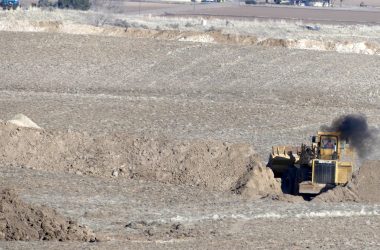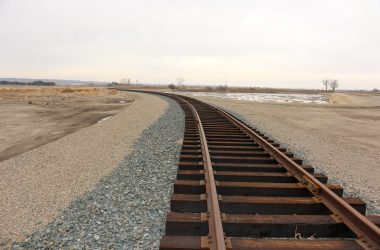NYSSA – Leaders of the Treasure Valley Reload Project won’t be forced to do a complete rebuild on miles of railroad track after Union Pacific Railroad last week approved a major change that slashed the depth of the rock needed for the rail beds at the site.
At issue was a cost-cutting move by the Malheur County Development Corp. made more than a year ago to lower the depth of subballast for the rail at the project site. Subballast is a layer of gravel that stabilizes rail tracks.
The change was not approved by Union Pacific as outlined in the contract the railroad signed with the development corporation.
Shawna Peterson, the director of the development corporation, said Union Pacific notified her of its approval of the subballast change, Tuesday, Oct. 31.
“It was a major relief. It is critical to serving the rest of the industrial park and the MCDC project. The rail is the greatest asset and it’s been the greatest expense and that it will proceed to be tied into the main line is a major step forward,” said Peterson.
Peterson said she isn’t sure when Union Pacific will complete work to tie the railways at the reload center site into its mainline.
“Everything is on site, so it is a matter of scheduling,” said Peterson.
The approval of the railroad for the change caps more than a year of apparent confusion between engineers while key construction steps were skipped, an investigation by the Enterprise found. The investigation relied on hundreds of pages of emails, engineer plans, contracts and internal development company records dating back to 2019.
The original approved plans between Union Pacific and the development corporation required one foot of subballast for the three miles of rail bed at the site.
Yet in early 2022 officials began to discuss changing the one-foot subballast requirement to a combination of six inches of rock and a layer of what is known as geogrid. Geogrid is a flexible but sturdy sheeting made of interlocking fabric blocks.
The wording of the pact between Union Pacific and the development corporation was clear.
The development corporation “must in all events obtain railroads prior written approval of the plans for any proposed track changes,” read the contract.
The engineering plans for the project also stipulated that “subballast must be approved by railroad prior to installation of rail, ties.”
Yet the geogrid plan contained one attractive element to project leaders: It would save money, potentially up to $200,000, according to records obtained by the Enterprise.
That was good news for a project that was, in the spring of 2022, already overbudget and behind schedule. However, the manufacturer of the geogrid, Tensar, recommended to project leaders they get an outside review of the subballast.
In the summer of 2022, R6 Contracting installed the subballast layer using the geogrid material, without prior Union Pacific approval.
Brad Baird, the lead engineer on the project, later advised the development corporation that Union Pacific inspected and approved what had been built. He repeated that in an interview with the Enterprise.
The subballast issue remined obscure until a Sept. 5 meeting when Baird reported to the development corporation that Union Pacific planned to connect its mainline to the reload center and wanted information about the subballast construction.
At that time a possibility existed project leaders may be compelled to replace three miles of track to meet Union Pacific’s subballast specifications.
The railroad told the development corporation “further analysis” was required before Union Pacific signed off on the change.
Peterson wasn’t the project manager when the decision regarding the subballast was made but said she was pleased Union Pacific approved the change.
“I feel great about it. It is good news. I was told by the engineers that it was good, but it wasn’t preapproved and it was outside the design that was approved,” said Peterson.
Grant Kitamura, an onion industry executive and president of the development corporation, said the subballast approval is a key turning point in the future of the rail center.
“Now we can move forward to finding an operator,” he said.
An email by the Enterprise to Baird seeking comment was not answered.
The reload center suffered a major setback in July when Americold, a multinational company expected to run the facility, bailed out of the project because it was not “financially viable.”
Since then, Peterson has been looking to attract a new operator for the facility.
The project is now stalled, after Peterson, with the approval of the development corporation, declared a pause as she works to develop a new plan for the reload center.
News tip? Contact reporter Pat Caldwell at [email protected]
HOW TO SUBSCRIBE – The Malheur Enterprise delivers quality local journalism – fair and accurate. You can read it any hour, any day with a digital subscription. Read it on your phone, your Tablet, your home computer. Click subscribe – $7.50 a month.




